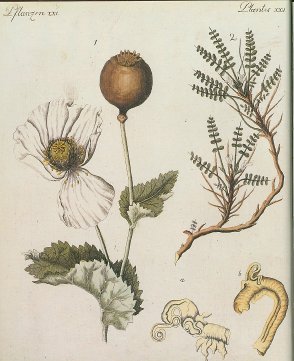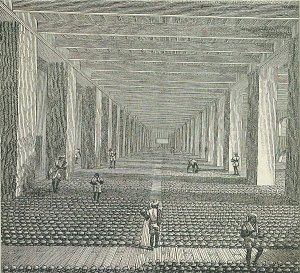Opium
In Oxford English Dictionary, the word 'opium' is defined as:

opium, n. 1. a. The extracted juice of a species of poppy (Papaver somniferum), obtained from the unripe capsules by incision and spontaneous evaporation, worked into cakes, balls, or sticks, of a reddish-brown colour, heavy smell, and bitter taste; valuable as a sedative and narcotic drug, and much used as a stimulant and intoxicant, esp. in the East.
Source: Porte-feuille des enfans, vol. !, no. 99, by Charles Frederic, 1795.
Le Pavot Blanc (Opium Poppy). The plant on the left is opium poppy.
Before engaging in a discussion of the Opium trade in Victoria, its historical context should be given consideration. In the early 19th century, the plant Papaver Somniferum - commonly known as the poppy - was widely grown in Malwa, Benares, and Behar in India by British plantations.1 First, workers removed and set aside the poppy petals. At sunrise, a blade incised the pods vertically to exude sap. The extract is then collected, drained, and then air dried or sun dried. Then, the dried opium was tossed into tanks and kneaded by men treading the mass. Opium for domestic market was formed into cakes and wrapped with oiled paper; opium for export was rolled into gum-like balls and pressed into bowls. These bowls were lined with a layer of petals. When the balls dried, it was covered powdered leaves, capsules, and stems. Lastly, they were stored in a dry place until ready to be packed into chests.
Source: Fernand Honore, "L'Opium en Indo-CHine," in L'illiustration, 1896, pp. 174-75.

Once the raw opium is formed, it is then packed into wooden chests weighing from 125 - 140 lbs. It is then shipped to Hong Kong or other parts of China. The scale of which the opium-manufaturing operated is immense. Kipling was told that at the height of the season, some &3,500,000 worth of opium was stored in numerous storehouses in Ghazipur.2 Another example, in 1837 about 40,000 chest valued at $25 million were expored to China.


"The Indo-Chinese Opium Trade: Notes at an Opium Factory at Patna."
These illustrations are remarkable in the depiction of the magnitude of the opium industry.
One the left is "The Drying Room"; on the right is "The Stacking Room."
Source: drawings by Lieut.-Colonel Walter S. Sherwill, The Graphic, 24 June 1882, p. 640.

Hong Kong - a british colony after the Opium War - became one of the greatest opium importers in China. Much of the raw opium was processed and refined into chandu or smokable opium. Labourers broke the opium balls in half and scooped out the gelatinus mass within. The outer shells were then boiled and all the opium from them were extracted through a repeated process of filtering through paper. This extracted opium was mixed with the gelatinous stuff removed earlier. Next, raw opium goes through a repeated process of boiling and roasting until it reaches consistency resembling molasses paste.
Source: Fernand Honore, "L'Opium en Indo-CHine," in L'illiustration, 1896, pp. 174-75.

"Smokers while asleep are like corpses, lean and haggard as demons. Opium-smoking throws whole families into ruin, dissipates every kind of property, and ruins man himself...It wastes the flesh and blood until the skin hangs down in bags and their bones are as naked as billets of wood. When the smoker has pawned everything in his possession, he will paw his wife and sell his daughters."
-- John Thomson, The Land and People of China
Source: Barbara Hodgson, Opium: A Portrait of the Heavenly Demon, 1999, p. 67
Opium, heroin, and morphine are all derived from poppy seeds. As narcotics, they are drugs that relieve pain, relax spasm, reduce fevers and induces sleep. It blocks messages of pain to the brain, producing euphoria and deadening anxieties and tensions. Nonetheless, these substances derived from the poppy are highly addictive and have detrimental side effects to one's health. Read more on smoking opium...